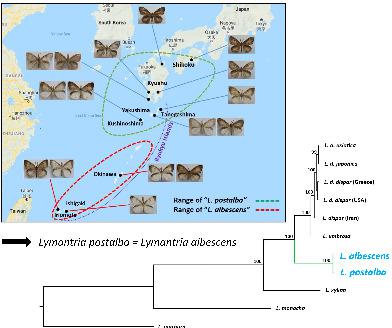当前位置:
X-MOL 学术
›
Syst. Entomol.
›
论文详情
Our official English website, www.x-mol.net, welcomes your feedback! (Note: you will need to create a separate account there.)
Reassessment of the status of Lymantria albescens and Lymantria postalba (Lepidoptera: Erebidae: Lymantriinae) as distinct ‘Asian gypsy moth’ species, using both mitochondrial and nuclear sequence data
Systematic Entomology ( IF 4.8 ) Pub Date : 2019-12-18 , DOI: 10.1111/syen.12410 Abdelmadjid Djoumad 1 , Audrey Nisole 1 , Don Stewart 1 , Dave Holden 2 , Reza Zahiri 3 , Maki N. Inoue 4 , Viatcheslav V. Martemyanov 5, 6 , Roger C. Levesque 7 , Richard C. Hamelin 7, 8 , Michel Cusson 1, 7
Systematic Entomology ( IF 4.8 ) Pub Date : 2019-12-18 , DOI: 10.1111/syen.12410 Abdelmadjid Djoumad 1 , Audrey Nisole 1 , Don Stewart 1 , Dave Holden 2 , Reza Zahiri 3 , Maki N. Inoue 4 , Viatcheslav V. Martemyanov 5, 6 , Roger C. Levesque 7 , Richard C. Hamelin 7, 8 , Michel Cusson 1, 7
Affiliation

|
For regulatory purposes, the name ‘Asian gypsy moth’ refers to a group of closely related Asian Lymantria species and subspecies whose female moths display flight capability, a trait believed to confer enhanced invasiveness relative to the European gypsy moth, Lymantria dispar dispar, whose females are flightless. Lymantria albescens and Lymantria postalba are Asian gypsy moths occurring in the southern Ryukyu Islands and in the northern Ryukyu and adjacent Kyushu and Shikoku Islands of Japan, respectively. Although once considered subspecies of L. dispar, their status as distinct species, relative to the latter, is now well established. While postalba was subsequently considered a subspecies of L. albescens, largely on the basis of differences in forewing ground colour in males, both taxa were later given distinct species status by Pogue & Schaefer (2007) following their revision of the genus Lymantria. Here, we re‐examined the validity of this revised status through the sequencing of a large portion of the mitochondrial genome (c. 60%) and multiple nuclear marker genes [elongation factor 1‐alpha (Ef‐1α), wingless (Wgl), internal transcribed spacer 2 (ITS‐2), ribosomal protein S5 (RpS5)] in representative specimens of both taxa and other Lymantria species, including L. monacha, L. xylina, L. mathura and members of the L. dispar + L. umbrosa clade. A comparison of the number of substitutions in these genomic regions among the taxa we considered showed lower or equivalent variation between L. albescens and L. postalba compared with subspecies of L. dispar, for mitochondrial and nuclear sequences, respectively. This finding was reflected in the maximum likelihood trees generated independently for mitochondrial and nuclear data, where L. albescens and L. postalba formed, in both analyses, a short‐branch sister clade basal to the L. dispar + L. umbrosa clade. We further sequenced three markers [cytochrome c oxydase 1 (COI), EF‐1α, Wgl] in multiple L. albescens–L. postalba specimens collected along a south‐to‐north transect across the Ryukyu Arc and observed no clear distinction among the sampled specimens as a function of taxonomic designation. We conclude that L. albescens and L. postalba form a single species, with postalba representing a darker‐winged morph along an apparent south‐to‐north wing colour cline. Accordingly, L. postalba is relegated to synonymy under L. albescens (syn.n.).
中文翻译:

使用线粒体和核序列数据重新评估 Lymantria albescens 和 Lymantria postalba(鳞翅目:Erebidae:Lymantriinae)作为独特的“亚洲吉普赛蛾”物种的状态
出于监管目的,“亚洲吉普赛蛾”这个名称是指一组密切相关的亚洲 Lymantria 物种和亚种,它们的雌性蛾表现出飞行能力,这种特性被认为赋予了相对于欧洲吉普赛蛾 Lymantria dispar dispar 增强的侵袭性,后者的雌性是不会飞的。Lymantria albescens 和 Lymantria postalba 是亚洲吉普赛蛾,分别出现在琉球群岛南部和琉球北部以及邻近的日本九州和四国群岛。虽然曾经被认为是 L. dispar 的亚种,但相对于后者,它们作为独特物种的地位现在已经确立。虽然 postalba 随后被认为是 L. albescens 的一个亚种,主要是基于雄性前翅底色的差异,但 Pogue 和 Schaefer (2007) 在他们对 Lymantria 属进行修订之后。在这里,我们通过对大部分线粒体基因组(约 60%)和多个核标记基因 [延伸因子 1-α (Ef-1α)、无翼 (Wgl) 进行测序,重新检查了这一修订状态的有效性, 内部转录间隔区 2 (ITS-2), 核糖体蛋白 S5 (RpS5)] 在分类群和其他 Lymantria 物种的代表性标本中, 包括 L. monacha, L. xylina, L. mathura 和 L. dispar + L . umbrosa 进化枝。对我们考虑的分类群中这些基因组区域中的替换数量的比较显示,与 L. dispar 亚种相比,L. albescens 和 L. postalba 之间的线粒体和核序列分别较低或相当。这一发现反映在为线粒体和核数据独立生成的最大似然树中,其中 L. albescens 和 L. postalba 在两种分析中形成了 L. dispar + L. umbrosa 进化枝的短分支姐妹进化枝。我们进一步对多个白化乳杆菌中的三个标记物 [细胞色素 c 氧化酶 1 (COI)、EF-1α、Wgl] 进行了测序。postalba 标本沿着横跨琉球弧的南向北横断面收集,并没有观察到采样标本之间作为分类学名称的函数的明显区别。我们得出结论,L. albescens 和 L. postalba 形成单一物种,postalba 代表沿明显的从南到北翼颜色的深翅变种。因此,L. postalba 被归为 L. albescens (syn.n.) 的同义词。在两种分析中,postalba 都形成了一个短枝姊妹进化枝,它是 L. dispar + L. umbrosa 进化枝的基础。我们进一步对多个白化乳杆菌中的三个标记物 [细胞色素 c 氧化酶 1 (COI)、EF-1α、Wgl] 进行了测序。postalba 标本沿着横跨琉球弧的南向北横断面收集,并没有观察到采样标本之间作为分类学名称的函数的明显区别。我们得出结论,L. albescens 和 L. postalba 形成单一物种,postalba 代表沿明显的从南到北翼颜色的深翅变种。因此,L. postalba 被归为 L. albescens (syn.n.) 的同义词。在两种分析中,postalba 都形成了一个短枝姊妹进化枝,它是 L. dispar + L. umbrosa 进化枝的基础。我们进一步对多个白化乳杆菌中的三个标记物 [细胞色素 c 氧化酶 1 (COI)、EF-1α、Wgl] 进行了测序。postalba 标本沿着横跨琉球弧的南向北横断面收集,并没有观察到采样标本之间作为分类学名称的函数的明显区别。我们得出结论,L. albescens 和 L. postalba 形成单一物种,postalba 代表沿明显的从南到北翼颜色的深翅变种。因此,L. postalba 被归为 L. albescens (syn.n.) 的同义词。postalba 标本沿着横跨琉球弧的南向北横断面收集,并没有观察到采样标本之间作为分类学名称的函数的明显区别。我们得出结论,L. albescens 和 L. postalba 形成单一物种,postalba 代表沿明显的从南到北的翅色线的深色翅形态。因此,L. postalba 被归为 L. albescens (syn.n.) 的同义词。postalba 标本沿着横跨琉球弧的南向北横断面收集,并没有观察到采样标本之间作为分类学名称的函数的明显区别。我们得出结论,L. albescens 和 L. postalba 形成单一物种,postalba 代表沿明显的从南到北翼颜色的深翅变种。因此,L. postalba 被归为 L. albescens (syn.n.) 的同义词。
更新日期:2019-12-18
中文翻译:

使用线粒体和核序列数据重新评估 Lymantria albescens 和 Lymantria postalba(鳞翅目:Erebidae:Lymantriinae)作为独特的“亚洲吉普赛蛾”物种的状态
出于监管目的,“亚洲吉普赛蛾”这个名称是指一组密切相关的亚洲 Lymantria 物种和亚种,它们的雌性蛾表现出飞行能力,这种特性被认为赋予了相对于欧洲吉普赛蛾 Lymantria dispar dispar 增强的侵袭性,后者的雌性是不会飞的。Lymantria albescens 和 Lymantria postalba 是亚洲吉普赛蛾,分别出现在琉球群岛南部和琉球北部以及邻近的日本九州和四国群岛。虽然曾经被认为是 L. dispar 的亚种,但相对于后者,它们作为独特物种的地位现在已经确立。虽然 postalba 随后被认为是 L. albescens 的一个亚种,主要是基于雄性前翅底色的差异,但 Pogue 和 Schaefer (2007) 在他们对 Lymantria 属进行修订之后。在这里,我们通过对大部分线粒体基因组(约 60%)和多个核标记基因 [延伸因子 1-α (Ef-1α)、无翼 (Wgl) 进行测序,重新检查了这一修订状态的有效性, 内部转录间隔区 2 (ITS-2), 核糖体蛋白 S5 (RpS5)] 在分类群和其他 Lymantria 物种的代表性标本中, 包括 L. monacha, L. xylina, L. mathura 和 L. dispar + L . umbrosa 进化枝。对我们考虑的分类群中这些基因组区域中的替换数量的比较显示,与 L. dispar 亚种相比,L. albescens 和 L. postalba 之间的线粒体和核序列分别较低或相当。这一发现反映在为线粒体和核数据独立生成的最大似然树中,其中 L. albescens 和 L. postalba 在两种分析中形成了 L. dispar + L. umbrosa 进化枝的短分支姐妹进化枝。我们进一步对多个白化乳杆菌中的三个标记物 [细胞色素 c 氧化酶 1 (COI)、EF-1α、Wgl] 进行了测序。postalba 标本沿着横跨琉球弧的南向北横断面收集,并没有观察到采样标本之间作为分类学名称的函数的明显区别。我们得出结论,L. albescens 和 L. postalba 形成单一物种,postalba 代表沿明显的从南到北翼颜色的深翅变种。因此,L. postalba 被归为 L. albescens (syn.n.) 的同义词。在两种分析中,postalba 都形成了一个短枝姊妹进化枝,它是 L. dispar + L. umbrosa 进化枝的基础。我们进一步对多个白化乳杆菌中的三个标记物 [细胞色素 c 氧化酶 1 (COI)、EF-1α、Wgl] 进行了测序。postalba 标本沿着横跨琉球弧的南向北横断面收集,并没有观察到采样标本之间作为分类学名称的函数的明显区别。我们得出结论,L. albescens 和 L. postalba 形成单一物种,postalba 代表沿明显的从南到北翼颜色的深翅变种。因此,L. postalba 被归为 L. albescens (syn.n.) 的同义词。在两种分析中,postalba 都形成了一个短枝姊妹进化枝,它是 L. dispar + L. umbrosa 进化枝的基础。我们进一步对多个白化乳杆菌中的三个标记物 [细胞色素 c 氧化酶 1 (COI)、EF-1α、Wgl] 进行了测序。postalba 标本沿着横跨琉球弧的南向北横断面收集,并没有观察到采样标本之间作为分类学名称的函数的明显区别。我们得出结论,L. albescens 和 L. postalba 形成单一物种,postalba 代表沿明显的从南到北翼颜色的深翅变种。因此,L. postalba 被归为 L. albescens (syn.n.) 的同义词。postalba 标本沿着横跨琉球弧的南向北横断面收集,并没有观察到采样标本之间作为分类学名称的函数的明显区别。我们得出结论,L. albescens 和 L. postalba 形成单一物种,postalba 代表沿明显的从南到北的翅色线的深色翅形态。因此,L. postalba 被归为 L. albescens (syn.n.) 的同义词。postalba 标本沿着横跨琉球弧的南向北横断面收集,并没有观察到采样标本之间作为分类学名称的函数的明显区别。我们得出结论,L. albescens 和 L. postalba 形成单一物种,postalba 代表沿明显的从南到北翼颜色的深翅变种。因此,L. postalba 被归为 L. albescens (syn.n.) 的同义词。



























 京公网安备 11010802027423号
京公网安备 11010802027423号